<– Start at the beginning of the Climate Lab series
Fiji, Part 3 – In the Field, Continued
The morning we left Suva for our visits to traditional Fijian villages, our cohort discussed things we might passively observe and actively explore while interacting with our hosts. Knowing how over-built the Fijian bureaucracy is, we were curious to see how much of what was planned at the top of the government actually trickled down to residents, from aid dollars to information. Knowing that decisions made elsewhere in the world would be impacting Fiji regardless of Fiji’s own actions, we were curious to see what type of adaptive practices were being employed, who was taking the lead in those situations, and what that leadership looked like. And knowing that adaptation inherently challenges traditional ways of thinking and doing, we were curious to see what types of practices had to shift – and what tensions might be arising from those shifts.
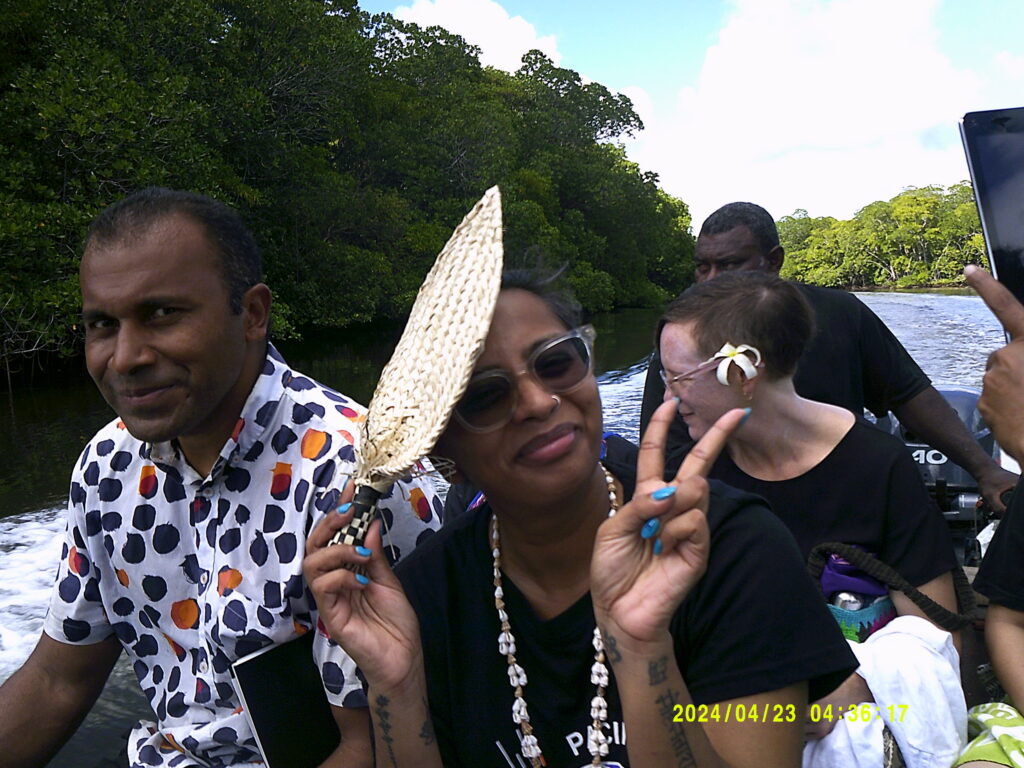
We each had multiple questions along these lines, and coming to the Climate Lab from a range of backgrounds (business, government, academia, non-profit, etc.), we each had a unique perspective on how these themes might manifest themselves in village life, from changing business decisions, to shifting gender roles, to evolving methods of how people receive and share information. Unfortunately, we had just over 24 tightly-scheduled hours on the ground, between arrival on Tuesday and departure on Wednesday, and that was not even enough to scratch the surface of what we had hoped to explore.
Anitioki Community
After breakfast in Daku on our second day, courtesy once again of the women of the village, we visited a nearby community that was part of the same clan. Men from Daku steered several motor boats along a mangrove-lined river to take us in groups to Anitioki. The spray of water and a cool breeze coming in from the ocean nearby were welcome on what was already becoming a hot and sunny day. A little over a mile away, and with many people we had seen the night before in Daku’s community hall, we were formally welcomed to the community with tea, biscuits, and – of course – kava. Over the increasingly generous pours of the bitter social lubricant, we heard their stories and their concerns.
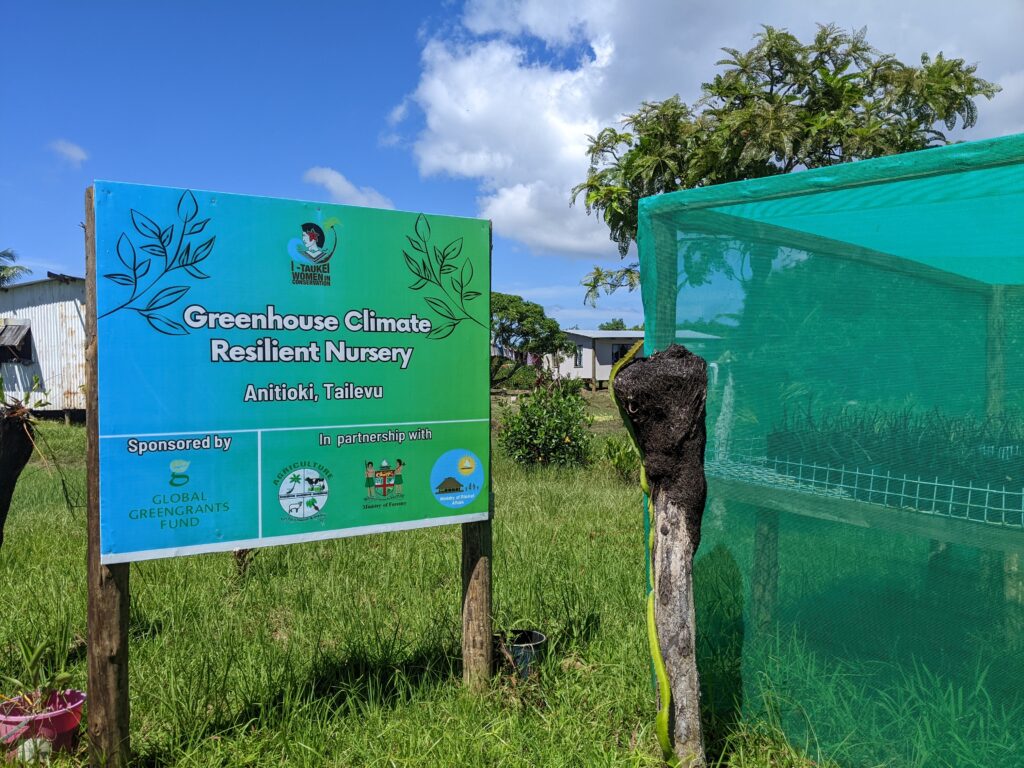
Coconuts represent a significant portion of Anitioki’s revenue. The village has a facility for refining coconut oil, but – being connected to Daku – the women also make and sell the famous Daku fan. [1] Sturdy, effective, and attractive, these hand-held fans are made from coconut leaves, and their method of construction is a secret known only by the women of Daku. (In fact, girls born in the village aren’t taught the secret because they will get married and move away; only women who marry into the village know how to do it.) Stacks of these handmade fans go to stores and markets in cities nearby, especially Suva, and there is enough demand for them that one family can make about $700 Fijian (a little over $300 US) in a week just from selling fans.
The rising sea levels, however, are impacting the health of the coconut trees and the size of the coconuts themselves. Therefore, similar to Daku, the community of Anitioki is trying to raise money for a sea wall to protect themselves and their coconuts. After our welcome ceremony (during which we were each gifted a small fan) and talanoa session, [2] we were given a tour of the first section of their sea wall. The sandstone structure (looking like a raised road to my untrained eye) was several hundred feet long – so far – and cost them around $10k just for the materials that had already been used. It was unclear how long it would take to raise enough money to build the rest of the wall, but it was clear that the small segment constructed thus far wouldn’t be effective on its own.
One of our classmates, an engineer who works in water management, asked about the decision-making process behind how the wall was designed and sited. She was incredibly polite in phrasing her question, but I could also tell that there was a reason she was asking. The answer was that the community had voted on where and how to construct the wall; there was no outside engineer or consultant involved in the planning or construction stages. It became clear that the people of the village were doing the best they could with the information and resources available to them, but the unsaid question remained: how effective would this expensive adaptation measure be, and for how long?
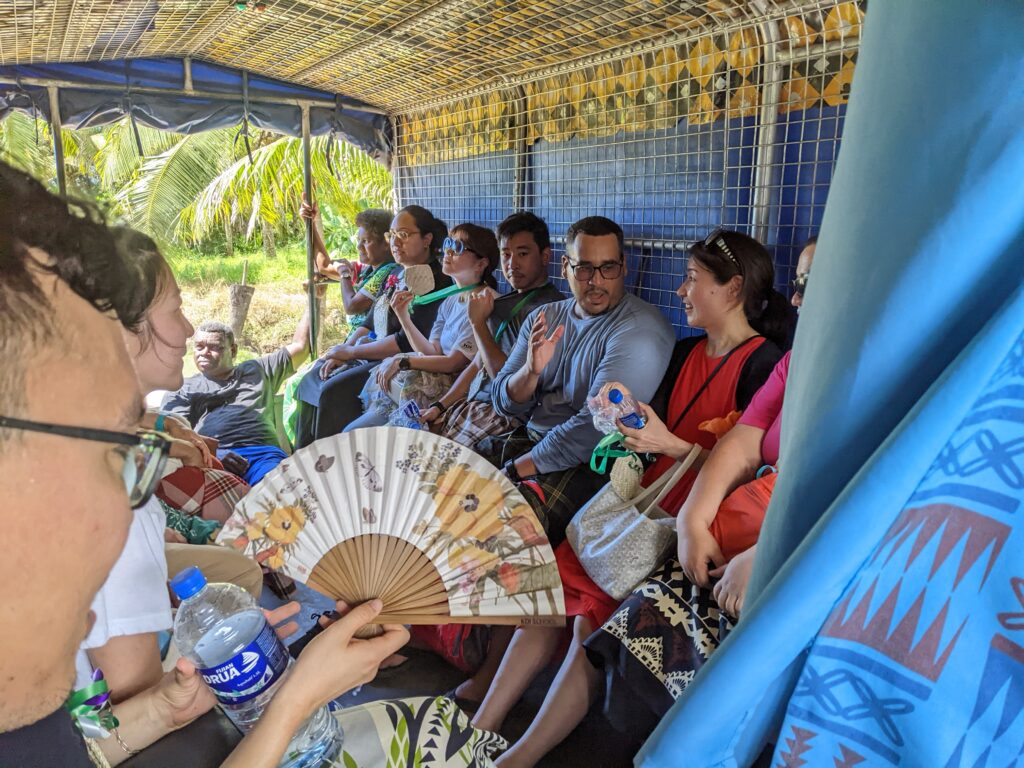
Kaleli Community
We began to wrestle with that thought as we said goodbye to our hosts in Anitioki and boarded the boats to return to Daku, where we then climbed into the back of a truck that would take us to our next visit in Kaleli. During the 15 minute drive along a washboard road, [3] we bounced around on the two benches that ran the length of the truck bed, grateful for the breeze created by our speed. When we arrived in Kaleli, another community with a clan connection to Daku, we were once again greeted for a formal welcome with kava, but this time, it was done outside, sitting on woven mats, underneath a huge shade tree. After the kava, we were also given fresh coconuts, each with a straw sticking out of the top, which were wonderfully refreshing in the heat of the afternoon.
Our hosts took us for a walking tour through the village, which ran only about 1,000 feet from the access road to the water’s edge. Here as well, looking out to the reef at low tide, we could see where ocean water regularly breached the rock wall, leaving channels in the ground after receding. We walked back to the straw mats for a talanoa session during our remaining time there, and I was looking forward to hearing more about their challenges and decisions the village had made related to climate change adaptation. However, upon returning to the group of villagers, I was surprised to see that they had now split into men and women, each group sitting on opposite sides of the village entrance; our cohort was then split as well, each of us being sent to sit with our own gender.
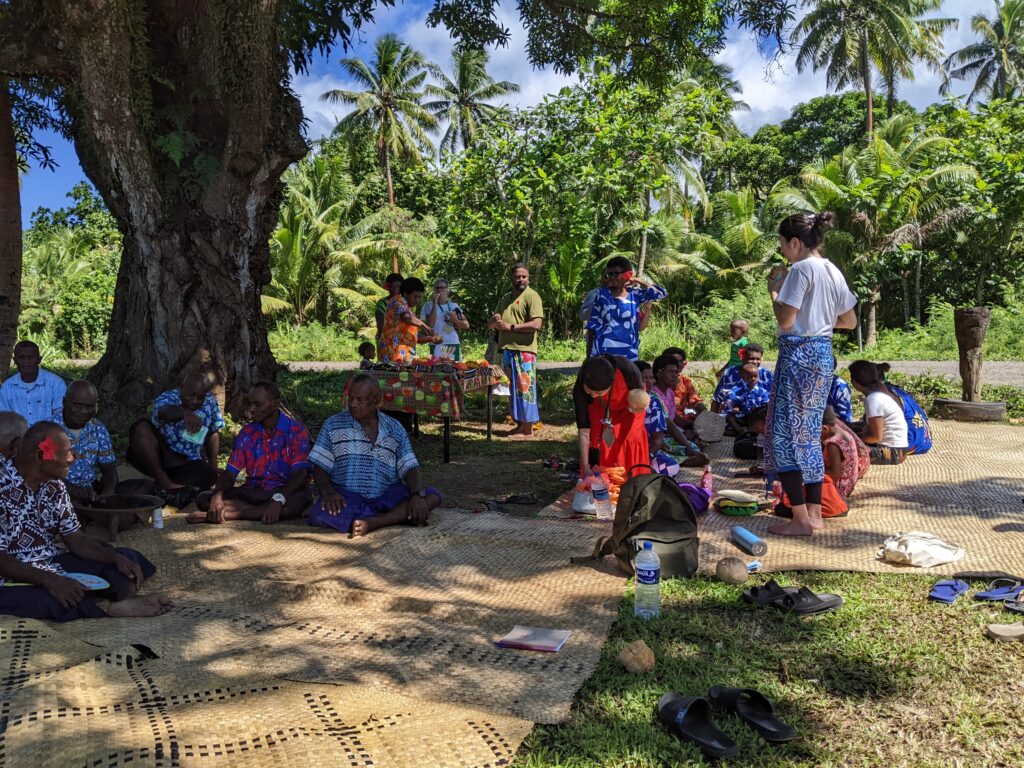
Again, my American bias made itself apparent. At home, I am not unfamiliar with sexism, especially in the business world, but the overt, formal segregation of men and women for this part of the visit was something that bothered me deeply. I didn’t want to be told where to sit or be excluded because of my gender; I wanted to sit where I chose so I could ask the questions I had developed to further my own research. Although I learned later that the split was impromptu, at the time it felt like the women were being sent away while the men discussed important business, and I was not happy about it. Upon further reflection over the next day or so I realized that by sitting with the women – and just the women – we were able to hear their perspective, particularly about things that they never would have said in front of the men.
Boys vs. Girls
During my first three days in Fiji, I had observed frustratingly consistent deference to men, not just in the villages we visited, but also during mixed-gender panel discussions in our classroom sessions, and by service workers addressing my husband (who was just tagging along with me on this trip). In a village setting, it is the men – almost exclusively – who sit around the tanoa (kava bowl) and speak during the talanoa sessions; women from the chief’s family are given more latitude to speak as they desire, but opportunities are limited for others. From observation alone, it appeared that men were in charge, and women were largely overlooked. Interestingly, the women of Kaleli explained (without any detectable notes of resentment) that they do hold leadership positions within their village committees and are, in fact, the ones who get things done.
As we sat together on a woven mat under a hand-painted banner saying “Welcome to Kaleli,” the women passed us bowls of kava (stronger than what the men had served us upon our arrival) as they described their days: they typically get up at 4am and go to bed at 10pm, sometimes later if they receive extra orders through Facebook for custom fans; they cook and do the housework (some of their husbands help, “sometimes”); they participate in village governance through committees (as treasurers, health care providers, and other roles that are standardized in villages across the country); and they manage the revenue that comes in from fishing and fan-making. Men will cut, cook, and dry the coconut leaves that are used to make the fans and will sell those processed leaves to the women (even to their own wives). When we asked why financial transactions took place even between married couples, the amused response we got was so that their husbands would have some pocket money.
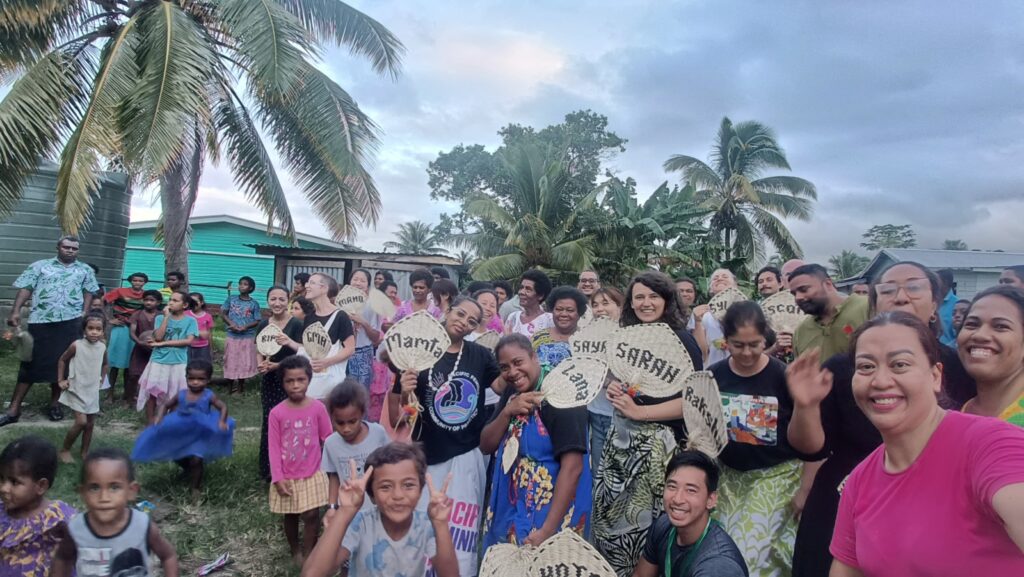
Photo credit: Angie Zafra
They also explained that if a man brings up a certain issue during a talanoa session, it is as likely as not that his wife has told him what to say. If a woman who has the status to participate in talanoa raises an issue, it is very likely about a topic that has already been under discussion by the women of the village: she is relaying the appropriate information through the appropriate channels, at the appropriate time and venue so that the issue gets the appropriate attention. (The men also follow this nuanced method that allows for difficult subject matter to be raised tactfully by those with higher status, but it appears to be a less restrictive and opaque process for them.) But the whole experience that day raised questions for me about what’s fair and effective when it comes to creating solutions to complex problems: who gets to participate – and decide – and how can we be sure that all relevant concerns are represented?
~
Riding the bus back to Suva that evening, many of us covered in sunburn, bug bites, and/or heat rash, but with personalized Daku fans in hand, we discussed what we had seen and heard during our visit and how our observations would inform our next steps – during our remaining days in Fiji, our remaining months in the program, and our remaining years of work in the climate change space. There will be much more on those thoughts next week.
Until then, thank you for reading!
The Indo-Pacific Leadership Lab [4] is a program of the East-West Center, [5] with support from the Japan Foundation. [6]
As always, content on this blog reflects my personal views, and not those of any organization with which I am associated.
[1] https://www.fijitimes.com.fj/people-the-famed-daku-fan/
[2] https://www.communityresearch.org.nz/wp-content/uploads/formidable/robinson4.pdf
[3] https://en.wikipedia.org/wiki/Washboarding
[4] https://www.eastwestcenter.org/projects/indo-pacific-leadership-lab
[5] https://www.eastwestcenter.org/
1 Comment
rjwarren59c8cb9109c0 · September 2, 2024 at 9:34 am
Wow,
This piece of work has so much weight of information. I am just left here pondering the whole trip. Even more the woman giving their husbands pocket change!!!! (on the down low). Again great piece of work.
You gather so much knowledge on these trip and the final word is our world is in a critical state with climate.
Because of Government, greediness, power and money. Lack of gratitude for your Earth.
So very sad for the inhabits of this beautiful planet. Thank you Alison for you love, dedication and hard work towards making a difference in climate change. Thank you for sharing your knowledge so that we to can make a change and help our planet to be more healthy.
AB